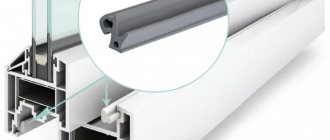Traditionally, with the onset of the heating season, the number of requests from customers with a request to adjust plastic windows increases. One of the common problems is that the upper corner of the plastic window does not press. This leads to a number of unpleasant consequences:
- There is a draft at home or in the office.
- Condensation forms on the glass and flows onto the windowsill.
- At sub-zero temperatures, ice forms on the frame, increasing the risk of cracks in the plastic.
If the upper corner of a plastic window comes off, then the sash hangs on the lower hinge, creating the feeling that the PVC structure has broken. But this is not so - perhaps the hardware settings have simply gone wrong. In most cases, if the window is hanging on one hinge, it can be adjusted and returned to its normal position.
First of all, you need to try to close the window using the following instructions:
- Move the handle up to the sash tilt position.
- Then lower it down, pressing the sash against the frame with your free hand.
If the window is hanging on one hinge due to improper use, but the fittings are intact, this will be enough to adjust the structure.
The door “fell out”, opening in two planes
This is the most common problem that occurs with tilt and turn mechanisms. If the user is in too much of a hurry to open or close a window, both systems are triggered simultaneously. The situation seems serious, because one might think that the sash is hanging on one hinge and is ready to fall off at any moment. But nothing bad happens. The problem is solved in just a couple of moves.
First you need to press the sash against the frame, applying force as close to the bottom hinge as possible. Then turn the handle vertically upward, press the sash and place the handle in a horizontal position.
In the vast majority of cases, everything works out the first time. If it was not possible to put the sash in place, the reason may lie in a jammed lock. After pressing the bottom of the frame, you need to feel for this mechanism, press with a little force, and, holding it in this state, turn the handle up until it stops. Then press the sash and place the handle horizontally, as described above.
Reasons for incorrect sash position
First you need to understand the factors that lead to such problems. In 90% of cases, the reason for opening a window in two positions at once is the incorrect operation of the fittings. The main harness (tires, scissors, extensions) is located at the end of the sash. The counter strips that secure the transom are installed on the end of the frame (impost).
Stages of operation of the fittings for different sash positions:
- Swing opening. When the handle is turned 90°, the strikers come out of the fixation of the hooks and the transom opens.
- Ventilation. The handle moves another 90°, the lower hook remains in the horizontal striker, providing support. The sash tilts to the distance of the upper scissors.
- Micro-ventilation. A special limiter has been added to the design, allowing the transom to be opened in ventilation mode by 3-5 mm.
When working in each of these positions, the elements may not function correctly.
The handle rotates without moving the mechanism
If the handle spins silently left and right, its body is most likely cracked. This means that it no longer secures the metal pin, which is supposed to transmit rotation to the mechanism. If you have a spare handle and minimal experience with a screwdriver, it will not be difficult to correct the situation. You need to remove the handle, turn the cover underneath, unscrew the fastening screws, and then install new fittings, following the included instructions. There is no need to involve specialists for this.
If a grinding noise is heard when turning the handle, the transmission mechanism is damaged. Such a malfunction cannot be eliminated on your own. You'll have to call a specialist
Aluminum sliding windows fall out onto the street from the balconies
This is not the first year that residents of the high-rise residential complex “New Pushkino” in Pushkino have been afraid to go outside; aluminum sliding windows can spontaneously fall on the heads of passers-by.
| Comment from WINDOWS MEDIA - it is not the windows that are falling out, but the sliding aluminum sashes from the glazed loggias. |
The shutters fall exactly in those places where people walk or sit on benches, and also reach the playground. Despite the fact that the doors have not yet fallen on people by luck, residents are sure that it is a matter of time. The area is actively populated. The developer is going to commission another 30 residential buildings, where several thousand people will live.
Residents have repeatedly appealed to the management company to solve this problem, but so far they have not taken any action, saying that these are the problems of the residents themselves, and they should monitor their windows. A representative of the management company stated that the incident of falling out was isolated, and the window (more precisely, the sash of the glazed loggia) fell out due to the fault of the apartment owner due to mechanical impact.
Homeowners were not satisfied with this answer. Such cases are not isolated, as evidenced by surveillance camera footage. As for the last case of falling out, the owner of the window could not influence the sash, since he was not at home at that moment.
People do not understand what to do with the windows, and intend to contact the prosecutor's office if the Criminal Code does not check all window structures and fix the problem in the near future.
Despite the fact that, according to residents, the masts have been falling out for several years, no one can explain the reason for this phenomenon.
The sash is skewed
If, when opening/closing a window, the sash clings to the frame, it means it is sagging. Hinges need adjustment. More precisely, they need to be tightened or loosened a little using a special 4 mm L-shaped hex key. By the way, they also adjust the density of the vestibule in case of drafts.
If tightening the hinges did not lead to the desired result, the reason is probably that the sash sank too much, or critical errors were made during the production of the window. In both cases, you will have to call a specialist.
Why might a window sash sag?
The main circumstance that causes the sash to sag is the impact of its own weight . Large windows with heavy sashes cause the most problems. For this reason, it is not recommended to open large windows for a long time.
Errors allowed during installation of the structure . Such situations are not uncommon when the installation technicians did not make proper adjustments, which led to difficulties when closing. If the order includes not only the production, but also the installation of a PVC window structure, you should monitor the stages of the work being carried out and check the quality of the actions performed. Thus, the customer will be able to exclude the possibility of subsequent defects due to broken installation technology.
Improper use of the window, particularly the sash, also causes sagging problems. You should not hang clothes to dry or other heavy objects on open doors. It must be taken into account that the design is designed only for the weight of the product itself, and does not guarantee successful operation if the window is not used for its intended purpose.
Loss of window elements from the structure that should hold the sash during transportation. The error will be eliminated, however, the geometry of the product may be disrupted - there may be a deviation from the perpendicular at the corners of the sash. The deviation may be unnoticeable, just a couple of millimeters, but even such a discrepancy will be enough to cause sagging.
The door is stuck in the tilted position and won't close.
With a high degree of probability, the problem arose due to mechanisms that had not been lubricated for a long time. Because of this, the “scissors” holding the sash stopped. You need to use machine oil, a liquid like WD-40 or a special spray , and then close the sash with a little force.
Note that, when choosing from the three listed liquids, it would be wise to give preference to a special spray for lubricating window fittings. This product lays perfectly flat, ensures good sliding of the moving parts, and, importantly, does not damage the seal if it gets on it. The same cannot be said about machine oil.
To avoid jamming of window mechanisms, you need to lubricate them at least once a year.
Another reason for a jammed sash is hardware failure. This is easy to check. You need to try to turn the handle with the window open. If it does not move, you will have to call a specialist from a service company.
Description of the problem
When I tried to open the window, it “fell out” of the groove and was left hanging on the lower hinge, which took on all the weight. The problem is relevant for all models, including products with an erroneous opening blocker. It may also not work, especially if you pull the window, which is in the folding position, sharply enough and rip it off its hinges.
Causes of annoying breakdown:
- installation work was carried out to a poor standard;
- the complete set of fittings was initially insufficient;
- the rules of use were grossly violated.
Similar situations arise in cases where the sash handle of the locking mechanism occupies an intermediate position, and you, without paying attention to this, sharply pull the handle to open the window. In this case, the sash either will not open at all, or, if you apply a certain physical force, it will fall out and hang only on the lower hinge.
What is an "intermediate position"? This is a position where the window handle is not installed in one of the three recommended positions. There are three of them:
- A mode in which the window sash is tightly closed - the handle “looks” straight down.
- The mode in which the sash is opened or closed - the handle is located strictly horizontally, parallel to the surface of the window sill.
- The mode of “tilting” the window sash for ventilation – the handle “looks” straight up.
The window is jammed due to the deformation of the opening or an error in size
This problem is indicated by deformed window profiles and cracks in the glass. Obviously, tightening the loops will not help the matter. Only installing a new window can solve the problem. Note that if distortions arose due to the fact that the manufacturer incorrectly determined the dimensions of the structure and made it larger than necessary, the buyer has the right to demand a free replacement. Although this may be difficult to prove. It will probably be necessary to involve independent experts.
At the end of the topic, we will answer that the manufacturers’ advice on caring for plastic windows has very good reasons. If you regularly lubricate the hinges and tighten loose mechanisms, the structure can last for decades. Double-glazed windows that have been in place since the 90s of the last century are real proof of this.
How to open a double-glazed window if the handle is jammed
It happens that the window handle remains in the “closed” position, but the window itself is open or vice versa. If you have closed the plastic window incorrectly, you may have difficulty opening it in the future. Let's look at the most common situations and find out what to do if the plastic window is stuck. The general rule applies for all situations. If the handle is stuck in one position and does not move, do not use too much force to turn it. All fittings should be treated with care. This is a guarantee of a long and trouble-free service life.
Replacing glass in a double glazing unit
Sometimes repairing plastic windows also includes replacing glass. This is much more complicated. First of all, you will need glass cut strictly to size. You can, of course, cut it yourself, and then process the edge so as not to get hurt. You can also order glass from a workshop and ask them to polish the edges.
Then the glass unit is removed from the plastic window frame and laid on a flat surface. It’s more convenient to place it on a table, but you can also use it on stools. If you work on a table, cover it with something.
Then use a sharp knife (or a wallpaper knife) to trim the silicone around the perimeter. Then the damaged glass is finally separated from the glass unit and removed. A new one, washed to a shine, is placed in its place and leveled. It should be the same size to the nearest millimeter.
Next, seal the glass with silicone sealant (not acrylic). We insert the tube with sealant into the construction gun, go around the perimeter of the glass, making sure that the seam is filled evenly. We wait until the silicone dries, then we take 40 mm wide tape and seal the glass unit around the perimeter. The glass in the double glazed unit has been replaced and can be replaced.
The window is stuck and won't open
In most cases, the reason is the blocker mentioned above, or rather, its untimely operation.
If you inadvertently turn the handle down in the open swing position and then close it, the lock may operate.
The further sequence of actions depends on the model of the mechanism. First you need to try to re-close and open the sash alternately in tilt and turn modes.
If the handle does not rotate fully to any of the open positions, try the following:
There are situations when the handle is not jammed, but, on the contrary, rotates around its axis, but the sash does not react in any way to the rotation. This indicates a breakdown of the fittings and in this case it is unlikely that you will be able to do anything on your own. The good news is that such breakdowns do not occur suddenly, but it all starts with play in the handle, which increases over time. Therefore, if you take timely measures and replace the faulty part, you can avoid unpleasant surprises.
Features of “cold” aluminum and plastic windows for balconies and loggias
Such windows are structurally different from standard ones - they have a different profile and fittings. Aluminum sliding window sashes usually have 1 piece of glass without a double glazed unit, while sliding plastic windows can also use a thin 1-chamber double glazed unit.
“Cold” aluminum and plastic windows work on a similar principle:
- there are no hinges in the sashes;
- the upper and lower guides fit into the central groove of the sash, thus holding the sash in the frame;
- the sashes are inserted into the frame and moved left and right using built-in rollers;
- There are 2 guides in the upper and lower horizontals of the frame, which are offset relative to each other. The doors of one row move along one guide, and the doors of the second row move along the other.
Why do the sashes of sliding windows on balconies and loggias fall out?
In the multi-storey residential buildings of the New Pushkino residential complex, exactly such sashes fell out of sliding aluminum windows with glass.
“Cold” sliding aluminum and plastic windows are the cheapest glazing designed to cover a cold balcony or loggia (not intended for living, without heating). They protect the loggia (balcony) from wind and precipitation. Photo: design of a plastic sliding window for balconies and loggias (section)
The valves may fall out in the following cases:
- the sash is made smaller in height with the correct frame height;
- The frame is made larger in height with the correct height of the sash. There may be a situation where, on one side, the height of the frame corresponds to the required one, and on the other, it is greater. When moving the sash to one edge, it can be firmly held, and fall out to the other;
- the sash is made smaller in height, and the frame is larger than necessary;
- During installation, the upper, lower (or both) horizontals of the frame were bent. The installers, while fastening them, stretched them (barrel-shaped frame). In the central part the frame became higher than at the edges.
Manufacturing and installation deficiencies may also be present together, thereby exacerbating the problem.
As a result, the frame guides do not go deep enough into the sash.
Photo: a situation in which a sliding sash may spontaneously fall out
Standard entry of the guide into the sliding sash for loggias:
- aluminum: 6.5 mm;
- plastic: 10 mm.
Photo: the depth of entry of the guides into the aluminum sliding sash For aluminum loggias this is a very small value. The rounded edges of the guides make the situation worse. Thus, even the slightest deviation (2-3 mm) downward from the required value will contribute to the sash falling out.
The likelihood of a sash falling out increases with the number of storeys - the higher, the greater. Wind loads at a height of 20 m and above (7-8 floors, and if non-residential premises occupy the 1-2 floors, then starting from the 5th floor) increase significantly. Due to gusts of wind, the sash may bend slightly, disengage with the frame and fall out.
If in previous years 9-story buildings predominated in multi-story construction, now the usual number of floors in buildings, for example in Moscow, is 24 floors; according to the renovation program, an average of 14 floors. At such a height, there is a high probability of aluminum sliding sashes falling out, even if the dimensions of the structure are respected.
| On high floors (from 20 meters in height) “cold” sliding window structures without window hinges should not be used!!! |











